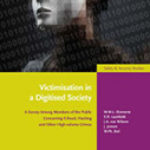UNDERSTANDING POLICE INTELLIGENCE WORK

Author: Adrian James
Publisher: Bristol: Policy Press, 2016. 172p.
Reviewer: Colin Atkinson | January 2017
The label of “expert” is oftentimes too liberally applied, particularly to academics. But having read Understanding Police Intelligence Work, I would have no hesitation in ascribing expert status to its author, Adrian James. This work provides a comprehensive introduction to, and strong engagement with, its central subject matter. James is a former detective and intelligence officer in the Metropolitan Police Service, and his book-length study draws extensively on his life and experience as a law enforcement practitioner. However, the author lifts this work above the typical pronouncements of the previously-employed practitioner by drawing information and academic rigour from a “standard social science mixed-methods approach” that incorporates extensive documentary research and deep qualitative research; the latter involved the collection of primary data from a wide range of actors across the policing hierarchy, from front-line staff to chief officers. Whilst exploiting his practitioner experience as well as primary research, James does well to avoid the type of myopic, taxonomical and expository account that can hinder such work. Instead, James provides a detailed, sophisticated and in many ways critical appraisal of police intelligence work that should be of interest to both practitioners and academics. Beyond such audiences, the general reader will also almost certainly find value in James’s work given that it is accessible, eminently readable and fluent in prose. The avoidance of jargon is particularly commendable.
The book’s nine substantive chapters are framed by an introductory chapter and a concluding epilogue. The first substantive chapter details the fundamentals of intelligence practice, with the remainder exploring a range of issues – including organisational structures, legal frameworks, processes, opportunities and failures – before the last chapter takes stock and looks ahead. All of the chapters are under 20 pages, which allows the writing enough space to breathe and to explore the topics under consideration in suitable depth, without overpowering the reader with unnecessary minutia. The organisational structures of police intelligence work outlined in the second chapter provide a useful overview of the agencies and organisations at play, and it is also strong on European and international dimensions. A key criticism here, though, is the absence of consideration of the Scottish context in the fight against organised crime and terrorism, particularly given the recent political and financial investment in the Scottish Crime Campus at Gartcosh. The apparent conflation of “England and Wales” with the “UK” is somewhat disappointing in this discussion.
One of the most valuable contributions is James’s overview of the National Intelligence Model (NIM) in chapter 5. James delivers a sharp account of the NIM since its adoption in 2000; an analysis that he usefully terms the “NIM narrative”. Essentially, James recounts the initial failure of the NIM to gain traction beyond the narrow confines of the intelligence world and into wider policing processes and practices, before a reappraisal and some significant efforts by stakeholders brought the NIM back from a period of purdah. In the same chapter James highlights some routine and mundane elements of intelligence work (e.g., information classification) as well as more recent developments (such as organised crime group mapping); the latter discussion could have been improved by deeper reference to some of the emerging and exciting academic work in this area.
There is an increasing recognition, particularly following the Edward Snowden revelations, that “big data” has become increasingly important in the roles, functions and practices of intelligence communities. Chapter 7 engages in a balanced way with big data and its impact on policing. James is undoubtedly correct that the full exploitation of the opportunities presented by big data will require significant investments in IT structures and personnel in policing. Recent experiences in Scottish policing, however, are indicative of the challenges such organisations face when seeking to deliver upgrades to IT systems that look to rationalise and harness the potential of the vast array of datasets that the police produce or to which they have access. If the police cannot fully harness the structured information that they themselves collect, the opportunities to exploit the more chaotic forms of big data that exist elsewhere – from social media to the “dark web” – may never be fully realised. James is clearly attuned to such challenges, both in U.K. policing and international law enforcement circles. The most astute insight of James’s account here, however, is his willingness to adopt a position “in praise of little data” in the context of police intelligence work. For James,
Much currently is made of the potential value of big data to policing. It seems likely that its impact on the policing institution largely will be positive, but, in the UK context, there is not yet much hard evidence of its worth. Largely ignored in the debate over its utility is the value of little data, which the police have relied on for as long as the institution has existed and which routinely provides tactical advantage (pp. 132-133).
In the echo chamber of police intelligence work “big data” resonates loudly, frequently drowning out “little data” as a future area of growth and exploitation. Whilst big data may be de rigueur in intelligence circles, little data should not be underestimated; from the value of the human undercover intelligence source operating clandestinely from within a criminal network, to the dividend of the covertly deployed technical device providing real-time coverage of conversations between criminals, or the significance of a single text message within a wider telephone billing. In this discussion James stimulates debate on the tension between police intelligence work as a science and police intelligence work as an art. The former may privilege the exploitation of big data through algorithms that interrogate blended data, but the latter may emphasise the importance of people in making judgement calls on smaller segments of information. This is not a zero-sum game, and James reminds us that little data clearly still has a role to play.
In the final chapter, which seeks to take stock and move forward, James’ appraisal seems entirely reasonable and justified: from the “harmonious and productive” partnership between the police and the Security Service in the context of counter-terrorism in the UK to a sagacious claim that intelligence staff would benefit from a broader exposure to the “different dimensions of intelligence work” (p. 148). It is hard to find fault with such insights. Nevertheless, there were some aspects of James’s account that were under-developed or fragmented. Such limitations can be attributed to the structure of the book, rather than any lack of understanding by the author. For example, in the first substantive chapter, which seeks to situate police intelligence work in context, the topics of the professionalization of intelligence work and the “surveillance state” are approached, but in a quite limited fashion. Arguably, one could very justifiably posit that, given a relative paucity of studies in the context of the wider literature, the topic of professionalization could have merited further discussion here. Given the ways in which professionalization is reengaged in the final chapter, some further provision of detail and contextualisation of this topic at an early stage may have been beneficial.
Examining the other side of this same coin it is clear that much work has emerged on the subjects of the “surveillance society” and the use of mass surveillance in both the pre-Snowden and post-Snowden periods, and a deeper engagement with these areas at the outset might have been beneficial, particularly in the context of accountability. Past and recent controversies concerning police intelligence work in the UK, especially police surveillance of environmental activists, have raised fundamental concerns over the practices of police intelligence officers (particularly those working undercover) and the ability of political representatives to hold practitioners to account. Some detail is given in a later chapter of the “oversight regime,” within which James floats the suggestion that,
Given the explicit responsibility if the IOCC [Interception of Communications Commissioner] to oversee and keep under review the interception of communications and the acquisition of communications data by SIAs, police forces and other public authorities, one equally might question whether there was more that the IOCC could have done to challenge the police and (particularly) the SIAs [Security and Intelligence Agencies] before Snowden brought their activities to public attention (pp. 67-68).
Embedding the nascent critical perspective within the wider literature on surveillance society, mass surveillance and accountability would have been a useful step. Nevertheless, one must place such concerns within the wider context of a book that adopts a sensible, manageable structure to deliver its key messages.
Overall, Understanding Police Intelligence Work provides an excellent introduction to its subject matter, highlighting the core concepts, themes and developments in this area and providing the reader with an excellent starting point from which to deepen his or her knowledge. This book demonstrates James’s expert knowledge of the topic in question but, more importantly, it is a medium through which even those who feel already informed about the concepts, issues and developments in this field can gain significant insight.
Dr. Colin Atkinson is a lecturer in criminology and criminal justice at the University of the West of Scotland, UK. His research and teaching interests focus on policing, intelligence and security.


